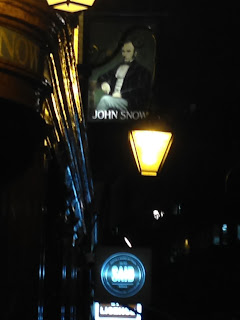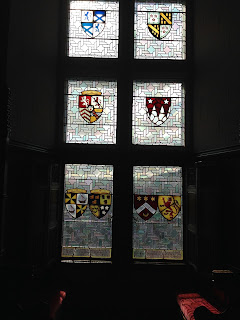One lesson I've learned is that reading stories and books within the genre you hope to publish is akin to doing primary scientific research. The old adage goes that the best writers of sci-fi are also avid readers of sci-fi. This is true in medical and other scientific research as well. I have to read several primary research articles a week to stay current on experiments, methods, and new discoveries in science. Doing so also gives me insight on how to tell my scientific "story" when it is time to submit my paper for peer-review.
There are lots of places to submit original sci-fi work, but I've learned that just as in scientific research, the story has to be the right fit for the magazine. At work I study the genetics of hypertension and cardiovascular disease, as well as human aging. My research paper on hypertension wouldn't make sense in a journal like Cancer Research. It's better suited for a cardiovascular-related journal. This rings true for publishing science fiction and fantasy. So I'm spending a lot of time reading through stories published in a variety of different publications to get a feel for where my stories can hopefully find a home someday.
Not only is this fun for me (because I love reading) but I'm also learning how others are honing their craft and becoming better story tellers. Over the months and years I've compiled a list of publishing destinations and magazines in science fiction, fantasy, and horror. For the non-writers who may be reading this, if you like any of these genres I would recommend checking out some of these websites. You may just find something you like. And for other authors, I hope this is helpful.
I've classified the list into subsections, as well as the "usual" word count of stories accepted under each magazine's guidelines. This is by no means an exhaustive list and each list is in no particular order. I am certain I am missing many publications and so I'll do my best to continue to update this list as I find more.
Science Fiction/Fantasy
Clarkesworld Magazine 1,000 - 16,000 Words
Nature Futures 850 - 950 Words
Lightspeed Magazine 1,500 - 10,000 Words
Daily Science Fiction 100 - 1,500 Words
Strange Horizons Up to 10,000 Words
Intergalactic Medicine Show Any Length
Acidic Fiction Not accepting (as of now)
365 Tomorrows Up to 600 Words
Bastion Magazine 1,000 - 5,000 Words
Shimmer Magazine Up to 7,500 Words
Flash Fiction Online 500 - 1,000 Words
Magazine of Fantasy and Science Fiction Up to 25,000 Words
Lakeside Circus Flash Fiction (<1,000 Words) or Short Fiction (1,001 - 5,000 Words)
Writers of the Future (Contest, up to 17,000 Words)
Hydra (Novels, at least 70,000 Words)
Analog (Varying lengths)
Asimov's Science Fiction Up to 20,000 Words
Horror
Nightmare Magazine (1,500 - 7,500 Words)
Dark Chapter Press (Dependent upon submission call)
The Horror Tree (Dependent upon submission call)
General Fiction/Misc.
Liars' League NYC (Generally 800 - 3,000 Words)
And now for something completely different:
When I was in Europe I snapped as many photographs as I could of the beautiful sights and landscapes. The amount of castles, stone circles, ruins, and glens makes it very easy to find inspiration for stories (I also recommend a small notebook to write down such ideas before they float away). Some of the places I visited no doubt inspired other writers. For example, below are two pictures of a bar that I walked past while in London. Fans of A Song of Ice and Fire (Game of Thrones) will recognize the name. I have no idea if George R.R. Martin ever saw this particular bar, or was inspired by the name, but I know he has frequented the UK so perhaps there is a link. (Again, I suck at taking pictures. My wife Julia is much better at it. But I can at least claim that it was raining, it was dark, and I was buzzed on some solid English beer.)
London is full of amazing places. No doubt seeing some of these sites made me think of great writers before my time and how they must have done their own research. Sir Arthur Conan Doyle undoubtedly did research before writing his Sherlock stories. You can't see the address very well above the door, but we stopped by 221B Baker Street to see if we could catch a glimpse of Benedict Cumberbatch (I mean Sherlock Holmes...of course). It was well past midnight and we did see a fox outside the house when we drove up....in downtown London. So perhaps Mr. Holmes was in disguise to avoid the American tourists.
Edinburgh, Scotland was a magical city. I've heard stories that George R.R. Martin traveled quite a bit in England and Scotland (apparently Hadrian's Wall was the inspiration of The Wall in his books). While in Edinburgh we visit Edinburgh Castle, and inside the Grand Hall were numerous stained glass windows with the sigils and crests of Scottish clans and families. As you can see below, some of them are eerily familiar to those described in the books. Unfortunately, I neglected to take a picture of the castle up close. I'll scour Julia's phone when she gets home.
Edinburgh Castle from across the city
Inside the castle walls
Windows in the Grand Hall
Of course, we also had to stop by a favorite haunt of J.K.Rowling - one of my most favorite authors. Julia was as excited as I was. However, the croissant I ate while there failed to unlock my inner muse and give me the inspiration to write a seven-book series that will make me a multi-millionaire. I should've asked for a refund.
On the trip I was also excited to meet up with another author who is building up his own publishing company - Dark Chapter Press. Located in Alnwick, England, Rob is a horror author and his press has featured some of my own horror stories on the website. It was a great chance to meet after working online together for over a year. Here's to hoping for future collaboration with D.C.P.! (A short story of mine will be included in an upcoming horror anthology published by D.C.P.- more on that later.)
Talking horror at Dirty Bottles with Rob (left) and Dark Chapter Press in Alnwick, UK
I'm continually surprised by the similarities in research, writing, and submission of either research publications or genre fiction writing. Hopefully I can use the success and failures I have in each field to improve my writing and story telling in the coming years.
Next week (or at least next post) I will be conducting a social experiment of sorts over a period of several months. It's time that I put my genetics knowledge to an informative use and I plan on doing something a little crazy to garner more discussion and communication in genetics, especially with my friends who don't do research.
Until then - Go Cubs! Back to the Future Part II predicted that the Cubs would be World Series winners this year. Wouldn't that be something if it really happened?













